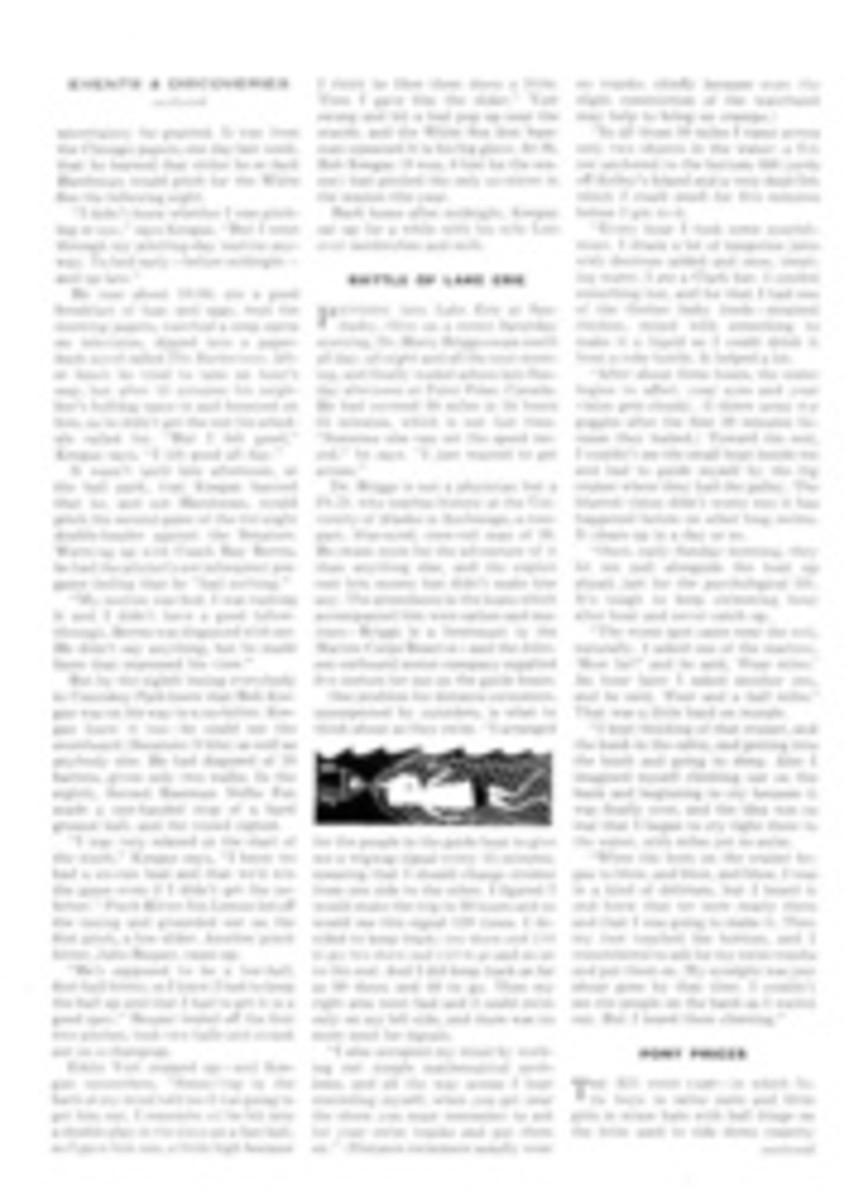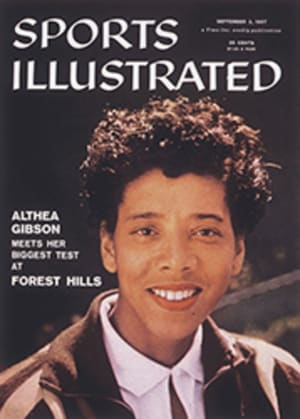
FOREST HILLS
Spectators attending the West Side Tennis Club's annual convention at Forest Hills next week will be seated in what is roughly the middle of Queens, a quite civic-minded borough equipped with 600 civic organizations, 44 separate communities, 10 miles of beach and 1.8 million citizens, most of whom live at hyphenated addresses that frequently run into eight figures.
Largest of New York City's boroughs, Queens is shouldered by Brooklyn on one side and green Suburbia on the other. It is washed by the Atlantic on the south and looks, on the north, to the pasturelands of the East Bronx and the fashionable East Side of Manhattan, an island to which it nightly flashes neon-illuminated messages concerning Sunshine Biscuits, Pepsi-Cola, Pearl-Wick Hampers and other handicraft made by the natives.
The very first natives were, of course, the Indians, mostly of the Rockaway tribe, who called Long Island Seawanhaka, another word for wampum. Moving over the river in one of the earliest migrations to the suburbs, Queens's next settlers set up abodes in one- and two-family houses that still stretch row upon endless row, one indistinguishable from the next under the soberest of circumstances. Later came the apartment houses, the latest of which is a vast complex of 32 glass buildings called Levitt Houses, built by Alfred Levitt at Whitestone, where the East River joins Long Island Sound. Here, for $155 for a three-and-a-half-room apartment, Queens natives get a 20-foot terrace, a woodsy site, the right to join a country club that has an ivy-covered brick-and-half-timber clubhouse, a swimming pool, moorings for yachts, and a French restaurant within full view of the Bronx across the bay.
Although all of Queens's 118 square miles is divided into addresses in which the street, the avenue and the location of the house on the block are inherent—104-41 204 Street, Hollis, is a typical one—out-of-borough trippers who enter the unexplored precincts of Queens would rather have a try at cracking the Japanese code than finding a house in, say, Jackson Heights.
On the other hand, no one en route from mid-Manhattan to the West Side Tennis Club's preserves at Forest Hills need spend more than a half hour at it, particularly if the tripper should sacrifice scenery in the interests of speed and take the subway.
HALF-TIMBERED AND IVIED
The stadium lies within the limits of a private retreat known as Forest Hills Gardens, a principality of brick roadways, gentle shade trees, seven apartment buildings, 875 homes and an ivied hotel. Forest Hills Gardens, which maintains its own sewers, owns its own streets and levies a tax on its residents, was an original project of the Russell Sage Foundation, which started it as a model community back in the early days of this century.
With its half-timbered houses and its Gothic-arch windows, the Gardens are meant to be a nook of England within sight of Manhattan, all patterned, so a spokesman says, after the Forest Hills of Britain. Englishmen, however, who are inclined to sniff at its architecture as "mock Tudor," are hard put to locate the original since there is a Forest Hill which is part of London, another in the Robin Hood country of Nottinghamshire, a third in Wiltshire and Forest Hill-with-Shotover, five miles from Oxford.
Despite these hazy origins, the Forest Hills Gardens Corporation, which took over from Russell Sage, retains the original rigid code that requires each house to be constructed of English architecture, to be covered with a red-tile roof pitched at 45°. No house-owner may install a picture window or a shutter that doesn't shut, and the building of fences is discouraged.
One of the Gardens' planners voted back in 1911 that the greenswards "cannot be used for active noisy games of large boys, nor will they be open to loafers." However, large boys and loafers coming in their own cars will at least be able to park in Forest Hills Gardens, since it is a practice for bicycle-riding youngsters of the area to make a deal with approaching motorists en route to the matches and then lead them to the family driveway where parking is available at anywhere from 50¢ to $2.
Boys larger than 18 years of age may slake their thirst at the Forest Hills Inn, one block from the stadium, repairing either to the Tournament Grill, a basement grotto with a brass-topped piano and photographs of old tennis players; or else at the oak-paneled Unicorn Lounge upstairs. A sidewalk cafe functions through the first days of September. Although four airlines use the place for their crews, the uncertainties of plane travel being what they are there is just no telling when Spencer Tracy, Ava Gardner or somebody will show up to while away a flight delay. Both airports are 20 minutes away.
But all Queens is not Forest Hills. A scant 10 minutes distant, in Richmond Hill, reposes the Triangle Hofbrau, a beery den featuring pickled lamb's tongue, imported wild boar and eels, fried, tartar or broiled. Jahn's, one of the nation's most famous ice cream parlors, is just across the street. Under old stained-glass lamp shades that say "Moxie" and "Coca-Cola," the brave can dispatch double-sized sodas served in vases; a "twosday," which is a soda with an extra ball of ice cream hanging like saddlebags on a pack mule on either side of a specially constructed glass; and "the kitchen sink," a $6 glut of ice cream covered with fruits, nuts, whipped cream and flames served in a silver container roughly the size of the Davis Cup.
Queens is the home of such resorts as Aqueduct, Jamaica and that 10-mile-long Atlantic watering place collectively called the Rockaways. (They were off and running at nearby Hempstead as early as 1665, in the words of a recorder of that day, "not so much for the divertisement of youth as for the bettering of the breed.")
The West Side Tennis Club has a somewhat similar objective.

